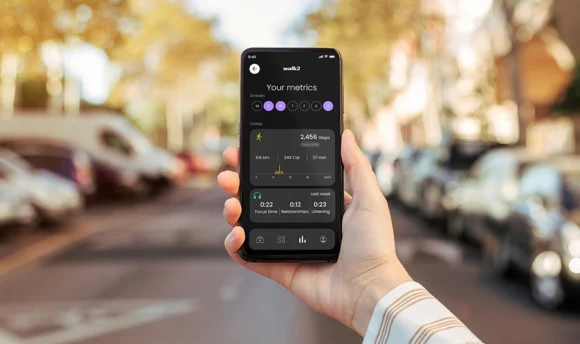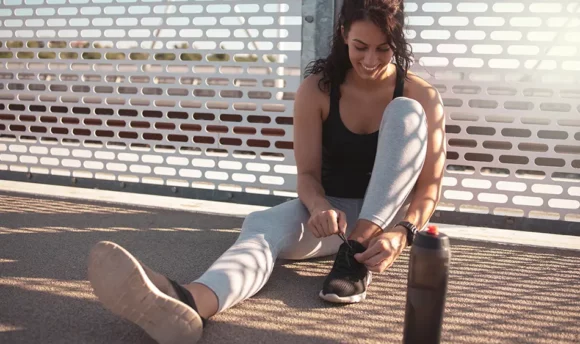6-Week Running Plan to Lose Weight: Most Effective Running Workouts
Running is a great, low-cost exercise for boosting your physical health, as well as your mental and emotional well-being. But is 6 weeks enough to reap the benefits of running and lose weight for good?

If you’ve got a weight loss goal to meet, running is a great way of upping your daily steps and helping you burn more calories. However, the thought of getting outside and pounding the pavement can be daunting.
Whether you’re a complete newbie to running or you have some prior experience, just getting started can be the hardest part. So, to help you overcome this fear and get you on the right track, we’ve created a progressive 6-week running plan.
Keep reading to find out how you could get into shape in just a month and a half and which running workouts are the best for shedding those extra pounds.
6-Week Running Plan to Lose Weight
If you’re hoping to burn plenty of calories through running, it’s important that you have a solid training program in place.
The plan below offers you a framework to follow when it comes to achieving your goals to ensure that you’ll be making progress on a weekly basis.
From walking, running, intervals, and strength training, it combines a variety of training methods to help build muscle strength, improve your endurance, and increase your speed, all of which are essential for getting better at running.
An important part of the program is the rest day and the lower intensity rest week 4, which ensures that you have plenty of time to recover from the stress of running and that you do not develop overtraining syndrome.
This also gives your muscles a chance to repair any microscopic tears you may have sustained, which helps them grow and become stronger.
By the end of this 6-week program, you should be able to run continuously for 30 minutes. This will significantly increase your heart rate over a long period, helping to get you in the fat-burning zone and drop those pesky pounds.
| Week 1 | Week 2 | Week 3 | Week 4 | Week 5 | Week 6 | |
| Monday | Warm-up: 10-minute walk Workout: 1-minute run, 1-minute walk alternated for 6 minutes Cool-down: 10-minute walk, followed by stretches | Warm-up: 10-minute walk Workout: 1-minute run, 1-minute walk, alternated for 10 minutes Cool-down: 10-minute walk, followed by stretches | Warm-up: 10-minute walk Workout: 1-minute run, 1-minute walk, alternated for 10 minutes Cool-down: 10-minute walk, followed by stretches | Warm-up: 10-minute walk Workout: 3-minute run, 1-minute walk, alternated for 12 minutes Cool-down: 10-minute walk, followed by stretches | Warm-up: 10-minute walk Workout: Run for 5 minutes, walk for 2 minutes, followed by 1-minute sprint, 1-minute jog, alternated for 10 minutes Cool-down: 10-minute walk, followed by stretches | Warm-up: 10-minute walk Workout: 10-minute run, followed by 1-minute spring, 1-minute jog, alternated for 10 minutes Cool-down: 10-minute walk, followed by stretches |
| Tuesday | Strength training | Strength training | Strength training | Strength training | Strength training | Strength training |
| Wednesday | Warm-up: 10-minute walk Workout: 1-minute run, 1-minute walk alternated for 8 minutes Cool-down: 10-minute walk, followed by stretches | Warm-up: 10-minute walk Workout: 1-minute run, 1-minute walk alternated for 12 minutes Cool-down: 10-minute walk, followed by stretches | Warm-up: 10-minute walk Workout: 1-minute run, 1-minute walk, alternated for 15 minutes Cool-down: 10-minute walk, followed by stretches | Warm-up: 10-minute walk Workout: 3-minute run, 1-minute walk, alternated for 12 minutes Cool-down: 10-minute walk, followed by stretches | Warm-up: 10-minute walk Workout: Run for 6 minutesWalk for 1 minute,followed by 1-minute sprint, 1-minute jog, alternated for 10 minutes Cool-down: 10-minute walk, followed by stretches | Warm-up: 10-minute walk Workout: Run for 22 minutes Cool-down: 10-minute walk, followed by stretches |
| Thursday | Strength training | Strength training | Strength training | Strength training | Strength training | Strength training |
| Friday | Warm-up: 10-minute walk Workout: 1-minute run, 1-minute walk alternated for 10 minutes Cool-down: 10-minute walk, followed by stretches | Warm-up: 10-minute walk Workout: 2-minute run, 1-minute walk alternated for 12 minutes Cool-down: 10-minute walk, followed by stretches | Warm-up: 10-minute walk Workout: 2-minute run, 1-minute walk, alternated for 15 minutes Cool-down: 10-minute walk, followed by stretches | Warm-up: 10-minute walk Workout: 3-minute run, 1-minute walk, alternated for 12 minutes Cool-down: 10-minute walk, followed by stretches | Warm-up: 10-minute walk Workout: Run for 15 minutes Cool-down: 10-minute walk, followed by stretches | Warm-up: 10-minute walk Workout: 15-minute run, followed by 1-minute sprint, 1-minute jog, alternated for 10 minutes Cool-down: 10-minute walk, followed by stretches |
| Saturday | Rest day | Rest day | Rest day | Rest day | Rest day | Rest day |
| Sunday | Warm-up: 10-minute walk Workout: 2-minute run, 2-minute walk, alternated for 12 minutes Cool-down: 10-minute walk, followed by stretches | Warm-up:10-minute walk Workout: 2-minute run, 1-minute walk, alternated for 15 minutes Cool-down: 10-minute walk, followed by stretches | Warm-up: 10-minute walk Workout: 2-minute run, 1-minute walk, alternated for 21 minutes Cool-down: 10-minute walk, followed by stretches | Rest day | Warm-up: 10-minute walk Workout: Run for 18 minutes Cool-down: 10-minute walk, followed by stretches | Warm-up: 10-minute walk30-minute run Cool-down: 10-minute walk, followed by stretches |
5 Best Running Workouts for Weight Loss
When it comes to losing weight through running, it’s important to try a range of workouts at a variety of intensities.
Longer, slower runs help you build basic endurance that allows you to improve your performance, maintain exercise over longer periods, and, therefore, spend more time burning calories.
On the flip side, quick, intensive interval training boosts your metabolic health and ups your calorie burn for hours after your run.
Overall, research shows that workout programs that combine a variety of intensities, along with eating a balanced diet, are the most effective at stimulating weight loss.
Keep reading to find out which are the best running workouts for weight loss and how you can include a range of them in your weekly training schedule.
#1 Interval training
Interval training involves periods of high-intensity running, followed by short active rest phases where you’ll jog or walk. During the working periods, you should sprint at approximately 90% of your maximum effort, meaning that you shouldn’t be able to hold a conversation.
This type of training forces you, your heart, and your muscles to work harder to maintain a faster running pace, which helps burn 20–30% more calories in a shorter period compared to regular cardio.
If you’re a beginner, you may want to start with shorter intervals, such as a 20-second sprint, followed by a 40-second jog or walk. You can then gradually build up to longer running intervals, with shorter rest periods as you become fitter.
#2 Sprints
Studies show that high-intensity sprint workouts help to improve aerobic capacity, the amount of oxygen your body can use at once, more significantly than moderate exercise.
Having a good aerobic capacity essentially means that you will be fitter because you’re able to perform exercises for longer and at higher intensities. As a result, you’ll be able to burn more calories in the long run.
Beginners should make sure to get 2–4 minutes of rest between each sprint set, as research indicates that those who only take 1 minute for recovery will struggle to keep up their performance in the next set.
Once you’ve built up your running strength and endurance, you may want to try hill sprints – running up a steep incline at 95% effort, before jogging or walking back down.
Not only is this a great way of mixing up your training routine, but the resistance provided by the incline helps to strengthen your quads, glutes, hamstrings, and calves.
Having stronger leg muscles improves your running technique and allows you to burn more calories in the long run.
#3 Tempo runs
Like interval training, tempo running is a type of speed workout where you run at a pace that you can maintain for at least 20 minutes, but ideally a longer period of 45–60 minutes.
Also known as threshold runs, research shows that incorporating this type of training into your schedule once per week builds your ability to run faster for longer periods, which helps you to burn a greater number of calories.
#4 Long runs
Going on long runs helps the mitochondria within your body become better at turning nutrients from the foods you eat into energy, meaning that you’re able to run faster and for longer.
Some studies have even shown that those who consistently take long runs at a slow or moderate pace have a lower risk of death from all causes than those who run with more vigorous effort, as well as those who don’t run at all.
This is because long runs strengthen your heart, helping it to work efficiently while delivering more oxygen and nutrients to the muscles that require them. Along with reducing your risk of cardiovascular disease, this also makes running long distances much easier the more that you train.
#5 Strength training
Alongside running, regular strength training is one of the best methods for helping you to sustain fat loss.
Whether you choose a barbell, dumbbell, or simply your own body weight, this type of training forces your muscles to work against an external form of resistance. To overcome this resistance, the muscles must adapt and therefore grow.
Bigger or stronger muscles require more energy to keep them working, meaning that they’ll burn more calories even at rest. By strengthening muscle mass and connective tissues, incorporating strength training into your program can also boost your running performance.
Research shows that it does this by increasing your speed, power, and aerobic capacity, which also lowers your risk of injury. Try to hit the weights 1–2 times per week, targeting all muscle groups to ensure that you don’t end up with any imbalances or weaknesses.
How Much Should You Run to Lose Weight?
There are 3,500 calories in one pound of body fat, and an average person burns approximately 8.5 calories per minute. So, to lose 1 pound per week, you’ll need to run 36 miles, burning 510 calories per hour.
To help you stick to your running goals and keep you accountable, you may want to use a running app to track your weekly workouts. For example, the Joggo app is specifically designed with beginners in mind and offers an individual training plan for each user.
Even if you are extremely motivated to run, 36 miles per week may be an unrealistic figure for the average person to achieve, especially for those who are just beginning on their fitness journey.
Guidelines suggest that you need to be in a deficit of 500–750 calories per day to lose weight, which can be created through consuming fewer calories as well as burning more.
So, if you’re following a progressive running plan but find that you’re hitting a weight loss plateau and are struggling to shift stubborn fat, you may want to take a look at your eating habits too.
Try to avoid drinking alcohol excessively, sugary foods, and simple carbohydrates, and instead pile up your plate with whole grains, leafy greens, and fruits.
As well as keeping your bowel movements regular, eating plenty of fiber is important as it is digested more slowly than sugary carbs, which helps to keep you fuller for longer. This reduces your chances of overeating and going over your daily calorie intake.
Incorporating foods that are packed full of protein into your meals, such as lean meats, greek yogurt, seafood, and cottage cheese, helps to reduce the production of ghrelin in the body, Known as the “hunger hormone,” having lower ghrelin levels helps to reduce your appetite.
FAQs
Yes, interval training is effective for weight loss as it causes your body to continue burning calories for hours after the workout is finished, which is called the “afterburn” effect.
If you’re hoping to lose weight, the best workout is a combination of slow, long runs with more intense, shorter interval runs. Longer runs help your body to burn fat for fuel, while working at a high intensity uses carbs and burns more calories overall.
The amount of weight that you can lose over 6 weeks will vary from person to person, depending on their genetics, diet, starting weight, dedication to running, and consistency. A safe and sustainable target to aim for is 1–2 pounds per week, so 6–12 pounds over 6 weeks.
Running every day for long periods of time increases your risk of sustaining overuse injuries, including shin splints, muscle tears, and stress fractures.
A Word From a Running Coach
Running is a fun and highly effective method of increasing your calorie burn and therefore losing weight.
If you’re hoping to sustain your weight loss over a long period, it’s important to stick to a weekly training plan that combines a variety of running types.
As well as preventing you from getting bored, this will also challenge your aerobic capacity and muscles in different ways while providing you with the motivation you need to keep running.
Along with exercise, diet is another crucial component to consider when trying to lose weight. It can be tempting to eat as little as possible to speed up weight loss, but this can actually have the opposite effect and cause your body to cling to its fat stores, eventually slowing down your metabolism.
You’ll also have less energy for running, so try to eat a balance of healthy fats, complex carbs, and protein-rich foods, as well as plenty of vitamins and minerals to maintain your immunity and overall health.
Conclusion
For those wanting to burn more calories and drop pounds faster, following a 6-week running plan is a great way of making progress.
Not only will this help to improve your running technique, but a structured program will ensure that you are able to work gradually towards your goals without overtraining or leaving you feeling overwhelmed.
To achieve healthy weight loss and fuel your runs, you’ll need to ensure that you’re eating a range of healthy, nutritious foods to stay in a calorie deficit. You should also take at least 1 or 2 rest days per week to prevent overtraining and reduce your risk of injury.

















































 Select your language:
Select your language: 








